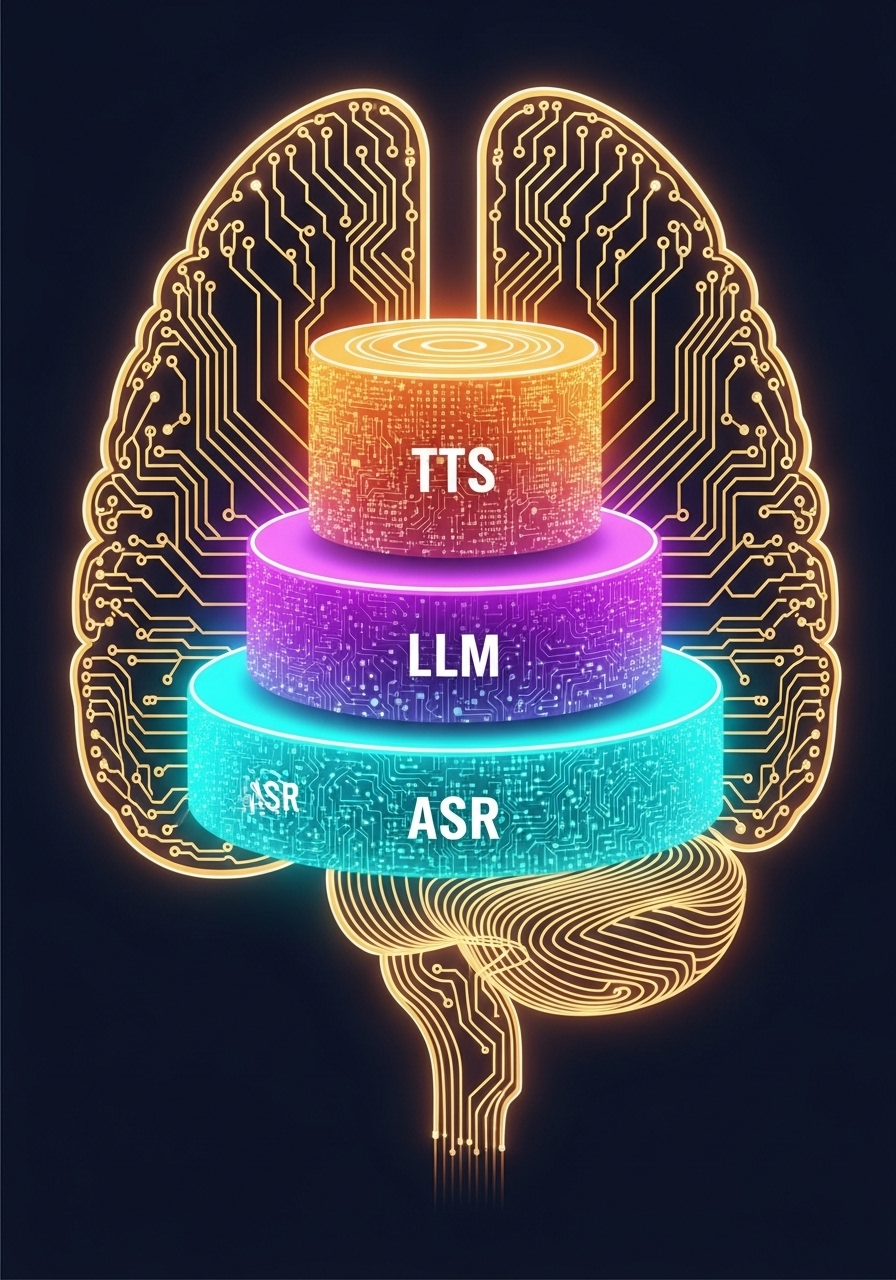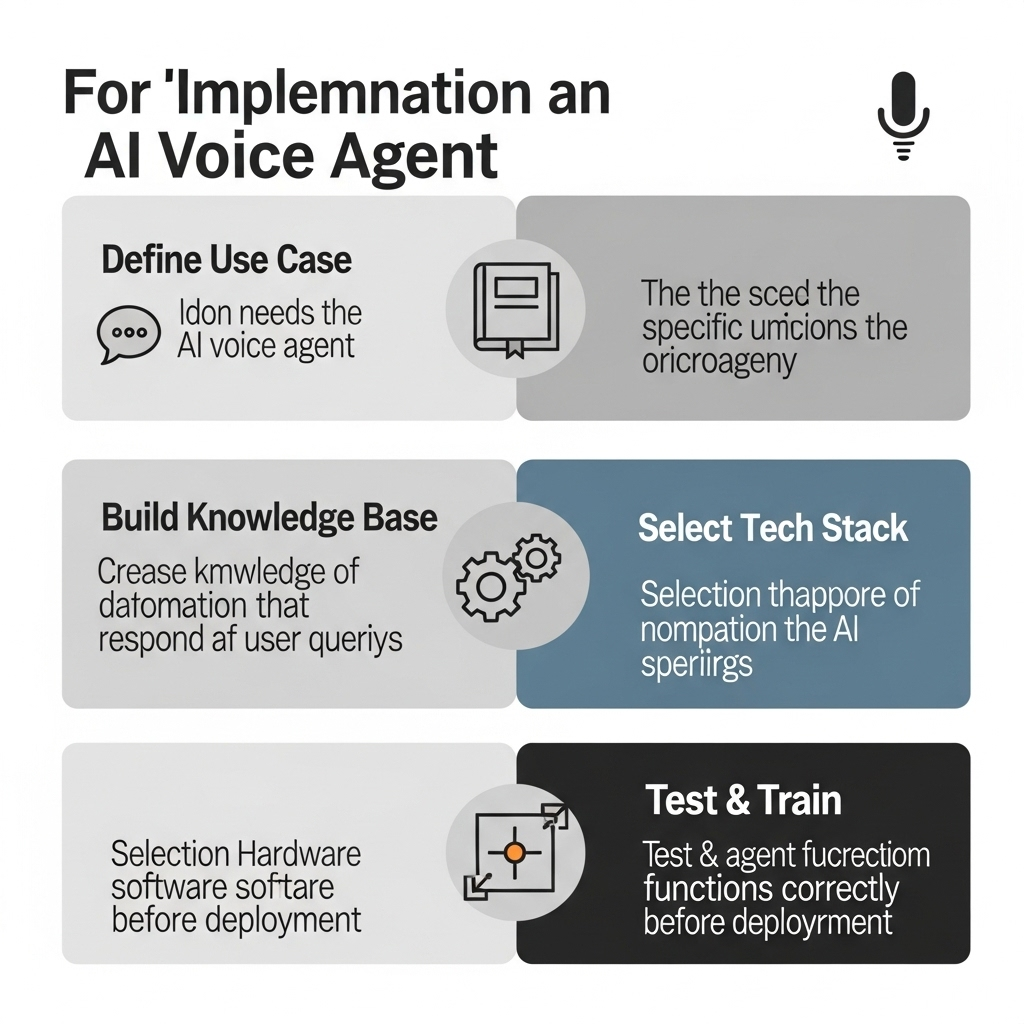Is That a Human or a Bot on the Line?
The next time you call a company, you may not hear the difference anymore. We dive into the world of AI voice agents that are already transforming customer service and explore what this means for your business and the future of software development.
The Silent Revolution
More Than a Robotic Voice
Why Modern AI Voice Agents Are Total Game Changers
Smooth Conversations: Forget the stuttering computer voices. Thanks to the combination of advanced language models (LLMs) and lightning-fast speech recognition, these agents can now interrupt, adapt and hold a completely natural conversation with no script.
Immediate Business Impact: The benefits are undeniable: drastically lower call-centre operating costs, 24/7 availability with zero wait times and a consistent, scalable customer experience. This is not a gimmick but a strategic asset.
Live Today: This is no longer science fiction. Major players in hospitality, e-health and retail already use this tech to take bookings and handle customer queries, often without callers noticing.
Fueled by Capital: A recent VC explosion—from a few hundred million to over two billion dollars in just two years—has pushed development into overdrive. The technology is here to stay and improving daily.

From 'Press 1 for...' to a Real Conversation
A Peek Under the Bonnet of the Modern AI Voice Agent
Have you ever battled your way through a customer service menu? 'Press 1 for sales, press 2 for support...' We all know the drill. Those rigid, impersonal systems, officially called Interactive Voice Response (IVR), often feel like a digital brick wall. They don’t really understand your question and force you down a predetermined path. Only recently I was stuck in one of those systems myself, desperately trying to get it to register the phrase 'invoice issue'—no luck. That era is finally over.
One development I have been keeping a very close eye on is the rise of genuine AI voice agents. This is a completely different ballgame. This new generation of systems is not built on simple scripts but on a powerful trinity of technologies that together create an almost human conversation partner. As software developers at Spartner we find this fascinating, because the magic lies in the seamless integration of complex systems.
So what exactly is under the bonnet?
The Holy Trinity of Voice AI
1. **Lightning-Fast Speech Recognition (ASR - Automatic Speech Recognition):** First, the system needs to understand what you’re saying, and instantly. Tools like Deepgram or Assembly AI have driven latency virtually to zero, turning spoken words into text in milliseconds. That is crucial because it lets you interrupt the AI mid-sentence; it will pause and listen—just like a human.
2. **The 'Brain' (Large Language Models - LLMs):** This is where the intelligence lives. The transcribed text is sent to a large language model such as GPT-4o. The model not only 'understands' the words but also the context, the intent and the underlying question. It can reason, look up information in a dedicated knowledge base and formulate a coherent, logical and empathetic answer.
3. **Hyper-Realistic Speech (TTS - Text-to-Speech):** The LLM’s answer is then converted back into spoken language. And this is perhaps where the revolution is most audible. Services like ElevenLabs or Cartesia generate voices that not only sound natural but also convey the right intonation, pauses and even emotion. They no longer sound like a robot but like a friendly, helpful employee.
What preoccupies us as developers above all is the architecture behind it. Success depends on robust API integrations, a scalable backend and the ability to make these different services talk to each other flawlessly. It is a beautiful example of how specialised AI components can combine to create something greater than the sum of its parts.

Implementing an AI Voice Agent? Our 4-Step Approach
From an Idea to a Working, Intelligent Conversational Partner
The idea of an autonomous AI running your customer service might sound like a project for multinationals, but the technology is becoming ever more accessible. The question is not if but how you approach it smartly. From our experience with complex software projects we know that good preparation is half the battle. This is the approach we use to turn such a project into a success.
**Step 1: Define the Use Case and Start Small**
Why do you want to deploy a voice agent? The answer 'to save money' is far too broad. Our approach is to identify the most valuable and feasible use case first. Is it to schedule appointments 24/7? To answer the top ten most asked questions outside office hours? Or to qualify incoming sales leads? By starting small you create value quickly and can learn and scale from there.
**Step 2: Build and Maintain the Knowledge Base**
This may well be the most important step. An AI is only as smart as the information you feed it. We spend a lot of time setting up a dedicated, ring-fenced knowledge base. This 'brain' contains all product information, company guidelines, FAQs and processes. That way we ensure the agent provides correct, on-brand answers and we prevent 'hallucinations'—making things up. The agent may draw only from this approved source.
**Step 3: Select and Integrate the Right Tech Stack**
There is no one-size-fits-all solution. The choice of specific tools (for example GPT-4o for the logic or Deepgram for speech recognition) depends entirely on the use case. Does the conversation require extremely low latency? Does the voice need a specific tone of voice? What scale is expected? What we do is design an architecture in which the best APIs for the job are integrated seamlessly, with a focus on reliability and performance.
**Step 4: Test, Train and Stay Transparent**
Before an AI agent speaks to even a single real customer it must undergo an extensive testing phase. We simulate dozens, if not hundreds, of scenarios. What happens when a customer gets angry? Or asks two questions at once? Or interrupts the agent? These tests are crucial.
**Pro-tip:** Always be transparent. Our advice is to have the agent introduce itself as 'your digital assistant' or Spartner's AI employee. The goal is not to fool people but to help them efficiently and pleasantly. Honesty builds trust, even with a bot.

The Business Case: Far More Than a Tech Gadget
The Strategic Benefits of the Autonomous Call Centre
Let’s be honest: as an entrepreneur or decision-maker you want to know what it delivers. A hyper-realistic AI voice is a nice technical feat, but what is the tangible value for your company? What I notice in practice is that the discussion quickly shifts from 'what does it cost?' to 'what does it yield?' The business case for AI voice agents is surprisingly strong and hits at the heart of your operations.
The Pillars of the Business Case
First, the most obvious: **costs and efficiency**. A human call-centre agent earns a salary, needs breaks, sometimes gets sick and does not work 24/7. An AI agent does. It can handle thousands of conversations simultaneously, day and night, without any loss in quality. The operational cost per handled call therefore plummets. Gartner predicts that by 2028 no less than 75% of new contact centres will rely on this technology.
Second, and perhaps more importantly: **customer experience (CX)**. What is customers’ biggest frustration? Waiting time. One study showed that the average person spends almost 43 days of their life in a queue. Imagine eliminating that wait entirely. Customers are helped immediately by an 'employee' who understands their question straight away and has the answer ready. Even if it’s an AI, a direct and effective solution is often perceived as more personal than waiting thirty minutes for an overworked human agent.
Third, **scalability and flexibility**. Have you got a seasonal peak or an unexpected marketing campaign that goes viral? A traditional call centre cannot handle that sudden pressure. An AI infrastructure can. Scaling up is a matter of server capacity, not recruiting and training dozens of new people. This gives companies unprecedented flexibility to grow and respond to market changes.
Finally, a benefit that is often overlooked: **data and insights**. Every conversation the AI holds is a source of structured data. What questions are asked most frequently? Where do customers get stuck? Which features of your product are unclear? The analyses of these conversations are gold dust for your marketing, sales and product development teams. You gain a direct, unfiltered look into the mind of your customer, and that is priceless for any organisation.

The Voice of the Future Is Already Here
What Does This Really Mean for Us and the Software We Build?
What fascinates me personally most about this development is the incredible pace. Technology that seemed like science fiction only a few years ago is now mature and widely deployed. The leap from clunky, robotic systems to fluent, empathetic conversational partners is enormous. It shows that the convergence of different AI disciplines can create exponential progress. For us as software builders it is a clear signal that we must keep learning and adapting constantly. The tools of today will be outdated tomorrow.
* **More Than a Bot:** AI voice agents have evolved into fully fledged conversation partners that understand context, can reason and adapt to the flow of a discussion.
* **Technology in Overdrive:** The combination of LLMs, fast speech recognition and realistic speech synthesis, fuelled by multi-billion investments, makes this possible right now.
* **An Unmistakable Business Case:** The gains in cost reduction, 24/7 availability, superior customer experience and scalability make adoption almost inevitable.
* **Transparency Is King:** The most successful implementations are honest. The goal is not to mislead the user but to deliver superior service. Tell them it is an AI.
* **New Opportunities for Developers:** This opens the door to building more complex, higher-value applications where the right software architecture and API integration are the keys to success.
Frequently Asked Questions About AI Voice Agents
The Answers to the Questions We Hear Most Often in Practice
1. **Doesn't this make customer service incredibly impersonal?**
Surprisingly, not necessarily. What is more personal: waiting on hold for 30 minutes for a human, or being helped within two seconds by an efficient AI? In our experience customers highly value speed and effectiveness. As long as the AI is friendly, empathetic and, above all, effective, it is often perceived as a very positive experience. The key is transparency: be open about it.
2. **Will call-centre staff lose their jobs because of this?**
The role will change, not necessarily disappear. The AI will handle the repetitive, simple questions. That gives human agents more time for complex, escalation-prone and emotionally charged issues where genuine human empathy and creativity make the difference. The role shifts from quantity (handling as many calls as possible) to quality (solving the toughest problems).
3. **How 'smart' is such an AI really? Can it deal with complex problems too?**
Its 'smartness' is directly linked to its training and the knowledge base we build. For standard questions and processes it is extremely capable. For truly unique or very complex issues the trick is to build guardrails. The AI must know when it doesn’t know something and transfer the call seamlessly and immediately to the right human expert.
4. **What is the difference compared to a standard chatbot on a website?**
The fundamental difference is the channel and the form of interaction. A voice agent has to listen, process and respond in real time during a spoken conversation. That requires far lower latency and the extra complexity of speech recognition and synthesis. It can also interpret the nuances of intonation and spoken language far better than a text-based chatbot.
5. **What are the biggest pitfalls in implementation?**
The biggest pitfall we see is poor preparation. This manifests itself in three things: an incomplete or incorrect knowledge base (causing the AI to talk nonsense), choosing the wrong tech stack that is not scalable or fast enough, and insufficient testing of real conversation scenarios.
6. **How do you ensure the AI sounds and speaks on-brand?**
We do this by working closely with the client in the preliminary phase. We define the tone of voice (formal, informal, enthusiastic?), craft the answers in line with the brand values and build the aforementioned knowledge base. The voice itself can often be adjusted as well to match the brand image.
7. **Isn't it extremely expensive to develop this?**
Although this used to be bespoke technology for only the very largest companies, the underlying platforms (such as those from OpenAI, Deepgram, etc.) are making it increasingly affordable. The cost depends on the complexity, but the return on investment is becoming ever more attractive. The question is no longer if it is profitable but when you step in.
What Is Your Voice in This Discussion?
Let’s Talk About the Future of AI and Customer Engagement
The world of AI voice agents is moving at breakneck speed. The question is not if you will encounter it but when. I am genuinely curious: what is your first thought when you imagine calling a hyper-realistic AI? Do you mainly see opportunities for your organisation, or do you shy away from the potential pitfalls?
At Spartner we love to brainstorm about these kinds of technological shifts. Share your thoughts or experiences in the comments, or send us a message if you would like to talk informally about what this could mean for you.
